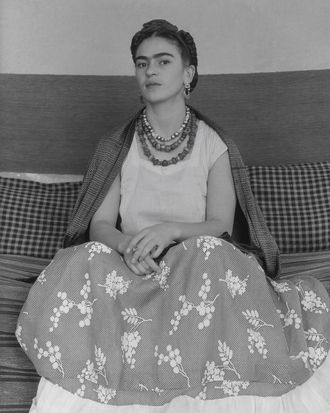
There have been many movies about Frida Kahlo over the years — including Julie Taymor’s well-regarded 2002 feature starring Salma Hayek, and Mexican director Paul Leduc’s artfully fragmented 1983 docudrama, Frida, Still Life — but none have given us such a sense of the artist as an actual living, breathing person as Carla Gutiérrez’s innovative new documentary, Frida. (The film is now available on Prime Video after premiering at the Sundance Film Festival.) Gutiérrez, an award-winning editor, has built the movie entirely out of archival material, using Kahlo’s own words and pictures to present her life as seen through her own eyes. Such an approach can have its limitations: Sometimes, you get a film that feels too carefully presented, too public-facing. In this case, however, much of the material has been drawn from the Mexican artist’s visual diaries. If anything, Gutiérrez errs on the side of naked intimacy.
Thus, we hear Frida’s own achingly confessional words (spoken by Fernanda Echevarría del Rivero) as she narrates her childhood, growing up with a deeply religious mother and an atheist father; her vivacious teen years as a hip young medical student, adored by many; her lengthy, turbulent marriage to the lecherous, revolutionary muralist Diego Rivera, who overshadowed her in her time; as well as her own passionate affairs with both men and women. By the time the movie is over, we feel, perhaps for the first time, like we’ve gotten to know this legendary, almost mythical figure. Despite the tumult of her life and her singularity as both a person and an artist, this Frida seems downright familiar.
Gutiérrez has also done something that some might consider a sacrilege. She has taken Kahlo’s drawings and paintings, including some of the most immortal ones, and animated them so that the images now shift before our eyes to reflect her emotional transformations, with pictures often mutating into one another. So that, as we hear Frida lamenting a miscarriage, we see the painting Me and My Doll, featuring the artist sitting distractedly next to a doll, morph into the skull and crossbones at the center of her forehead in Thinking about Death. The image of Diego Rivera (complete with a third eye) that appears on Frida’s face in Diego and I turns into a teardrop that runs down her cheek and becomes the throbbing, exposed, bleeding heart of The Two Fridas. The arrows piercing the body of The Wounded Deer slowly pop out and disappear to evoke spiritual healing.
It’s an inspired path into the work of an artist who often painted her own visage in visually striking arrangements. Purists may object, but the film isn’t trying to be pure; it’s trying to embody art in the messy process of becoming, just like the person who made it. It’s also trying to embody art evolving beyond the frame. Gutiérrez clearly sees Frida’s life in the work and not the other way around. When her paintings are discovered by the Surrealist poet Andre Breton and presented in Paris, Frida notes that not only does she not know or care what Surrealism is, she rejects the way her work is being presented. For her, the paintings aren’t symbolic or strange; they are, as she puts it, “the honest expression of myself.”
Symbolism suggests metaphor, analysis, artful avoidance. But Frida’s paintings are almost too raw, too exposed. She was in extraordinary physical agony throughout her life, owing to a childhood bout with polio and, famously, a horrific bus crash at the age of 18 that led to dozens of surgeries. Images of breakage, puncture, and cutting run throughout her work. The collapsing marble column that replaces her spine in The Broken Column is a direct expression of pain; it provokes not a knowing nod but a queasy wince. Gutiérrez embraces this underlying truth behind Kahlo’s work, and renders it cinematically. As a result, an artist who died 70 years ago gets a film portrait of arresting immediacy. Gutiérrez gives us a Frida we can believe in.


